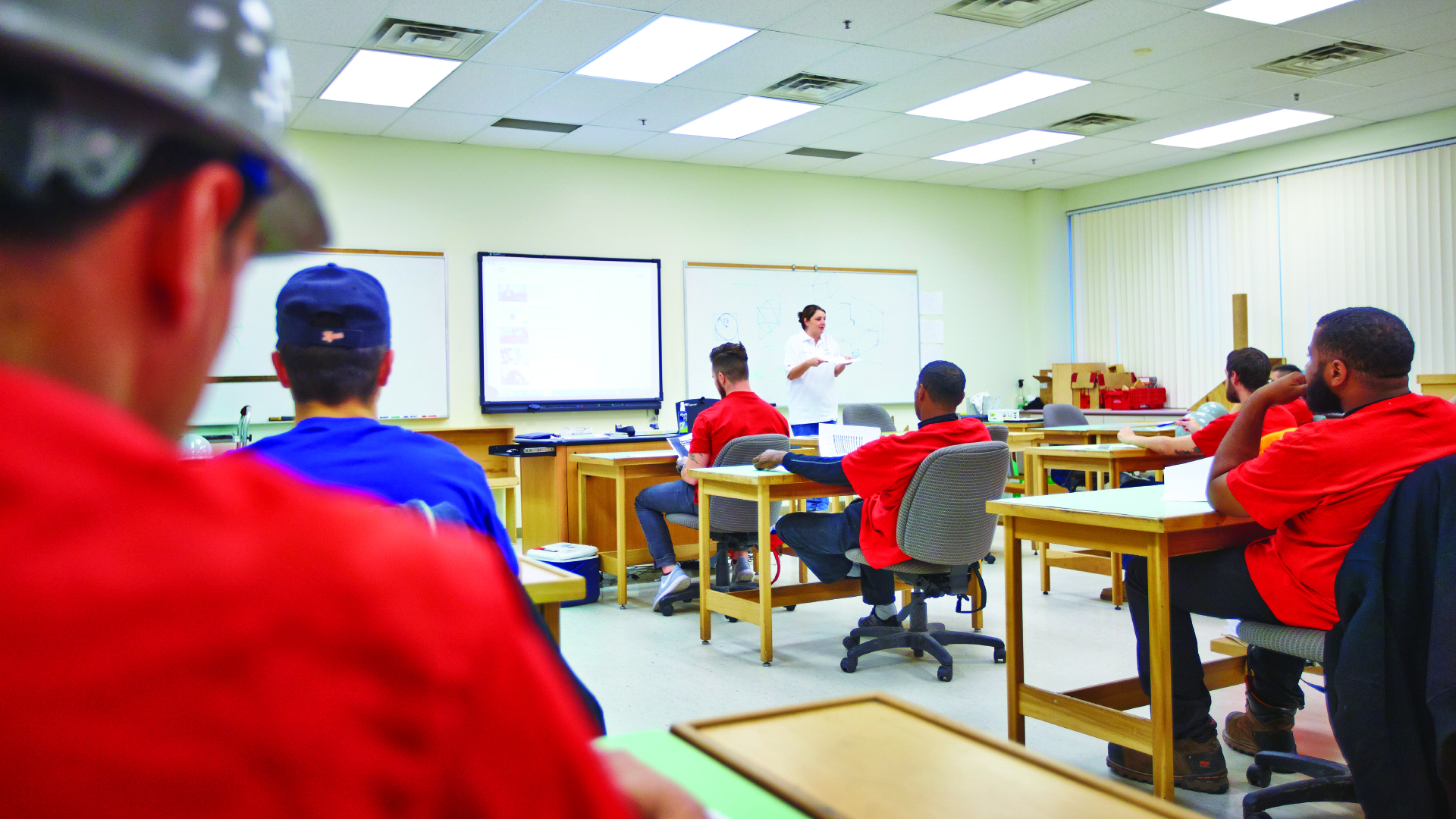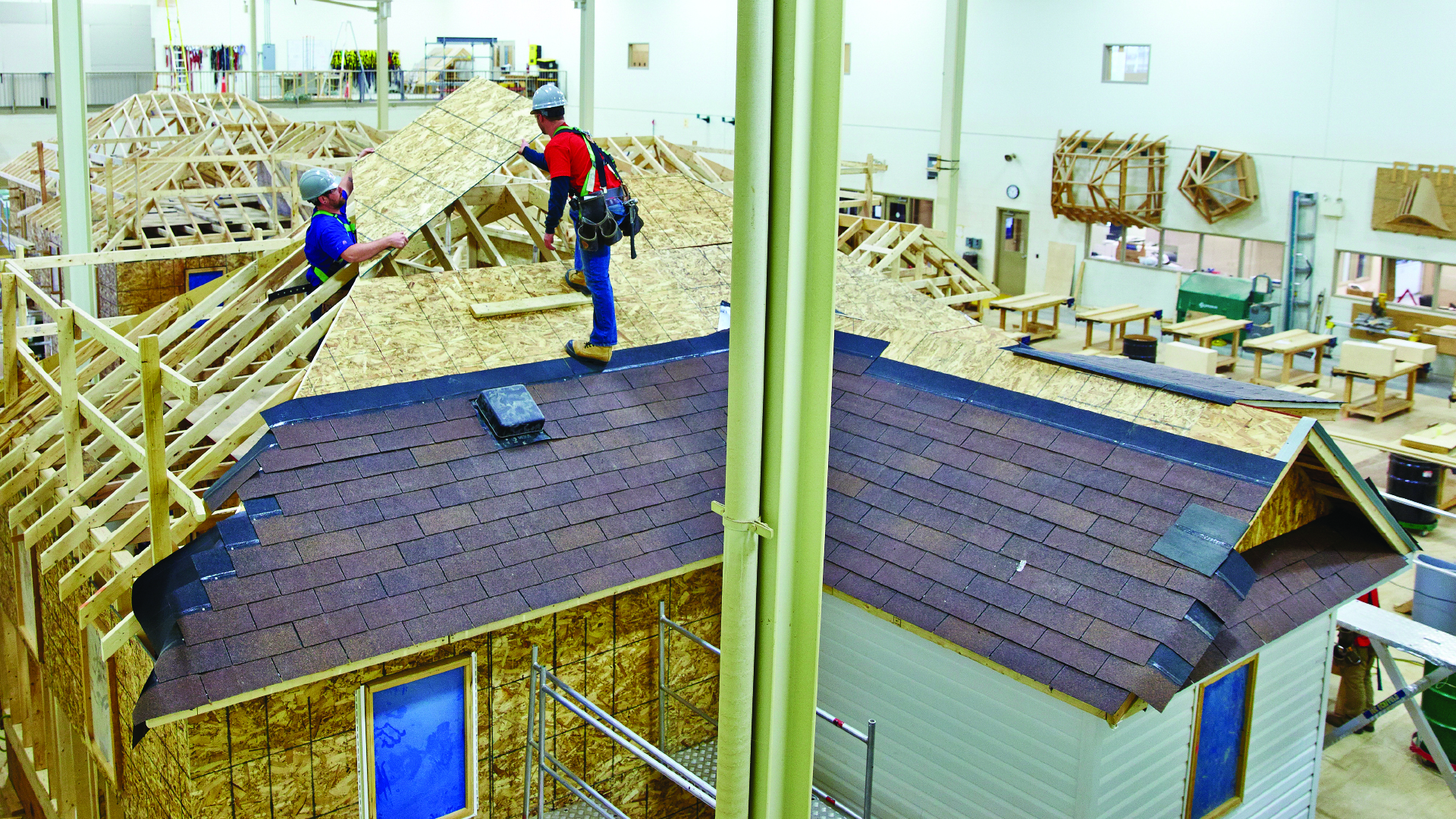Vaughan Rising Blog: How to Maintain a Talent Pipeline During the Pandemic
Four Strategies from the College of Carpenters and Allied Trades
The College of Carpenters and Allied Trades delivers construction skills courses in its two state-of-the-art facilities in Vaughan. Five thousand students come through the College every year, for training as short as a three-hour health and safety course or as long as an eight-week apprenticeship program. Fun fact: The College is home to half of all registered carpenter apprentices in Ontario!
Some of this training happens in the classroom, but the magic happens in the “hands-on” shop spaces where students work on full-scale construction projects.
As you can imagine, this kind of hands-on training doesn’t translate well to a virtual environment, so when COVID arrived, Mike Yorke, President of the Carpenters’ District Council of Ontario, said the College needed to rethink its approach–and fast–because construction projects roared on during the pandemic, barely missing a beat.
Trades still in high demand during the pandemic
Demand for skilled workers was already high, and the talent pipeline for skilled trades already tight, without a disruption to the talent pipeline. But with COVID-19 measures in place, the College is not able to train as many people at once as they used to. This impact on training has far-reaching effects down the entire pipeline.
“Carpenters are not alone,” Mike shares. “None of the trades and colleges are actually getting people through that pipeline as fast as they are needed. It has become a challenge for the industry at large.
“For example, in Ontario, our hours are only down by 4% from last year. So COVID has not really impacted us in a huge way in terms of working hours in construction. And we’d be very similar. I’m hearing across the board, multiple trades, multiple cities in Ontario, everyone’s hard at work.
“So then it becomes a question of how you get that next generation trained and out into the industry to pick up the slack, and to play a role in terms of their training. Because 90% of apprenticeship training takes place on the job site. Only 10% takes place in the school.”
Those school hours are very important, because the classroom provides basic, intermediate, and advanced training, as well as health and safety. However, it is a challenge to get people through the training program with class size cut to one-third.
Mike says, “Right now, in Toronto, the concrete forming industry is undergoing a big boom due to a combination of projects including the LRT along Eglinton, multiple corporate office towers, and multiple buildings in the condominium sector.”
He notes, “Concrete forming is a big area of ours. For my local here in Toronto, the GTA accounts for about 50% of our overall hours. So contractors are phoning every day. They need workers. They need an apprentice. They need someone to be trained and so before you go on the job site, you have to do the equivalent of about 24 hours of health and safety training. This includes courses on fall arrest, working at heights, WHMIS (Workplace Hazardous Materials Information System), and confined space. Then you’ve got all these young people that want to get into our industry, so that is a big challenge for us to get them the training they need; there’s no question.”
Four things the College is doing to maintain the talent pipeline
1. Get back up and running at a safe capacity
Mike recalls, “Like so many other organizations we were basically shut down from the middle of March until July, and then we began to reopen while implementing a series of protocols – smaller class sizes, additional class space, and handwashing facilities.
“Then we had a screening process, so we slowly implemented getting back to somewhat normal in terms of training. We also communicated with the Ministry of Labour, Training and Skills Development, because that ministry had to give us the green light to go back.”
He does admit there were some challenges of course, but the College is now running at about one-third to one-half of former class sizes, at an average of six students per instructor.
Where possible, they did make classes virtual. For example, a course that used to be three days in school is now taught online for the first two days and then the third is in-person with a smaller class size.
In-person training resumed in July with a new protocol to keep everyone as safe as possible:
“That was a high priority for us – health and safety – and ensuring a safe work environment for the students, instructors and any visitors that might attend,” Mike explains. “Initially when we started doing the screening of our students as part of our protocols, we set that up in a tent. One of our members was screening people for temperature, getting signed documents from them, and conducting a short interview each day prior to class starting.”
2. Implement health and safety changes to facilities and protocols
The tent worked for the summer, but as the weather cooled it became less comfortable. Then through his industry relationships, a perfect solution appeared on Mike’s radar: the Citizen Care Pod.
The Pod was co-created in response to the COVID pandemic by Carl Demarco of Camillion Corp. and Zenon Radewych of WZMH Architects. They wanted to create a safe zone for construction sites so that work could go on: a booth, made of shipping containers, which front-line workers can use to comfortably screen and test anyone entering the site.
Here’s how Zenon describes it, “So basically this pod is in essence really a building. It’s a small little building fully heated, air conditioned, pressurized, and well ventilated. It’s finished inside with easy-to-clean materials and finishes that you would see in a laboratory, such as stainless-steel counters.
“With lots of options for tables and storage, the Pod is set up to be a very safe environment for the front-line staff that are doing the testing and screening. It’s a lot more efficient, they feel a lot more comfortable and a lot more safe.”
Everyone arriving at the College has to check in to the Citizen Care Pod, and if they pass the screening, then they can go inside.
3. Adapt to incorporate new knowledge and circumstances
The experience of going to school has certainly changed, but this all-encompassing pandemic isn’t just changing how courses are being taught. It’s also changing what’s being taught. The curriculum is changing in response to the pandemic, providing students with content that is relevant to the new normal on work sites.
“We’ve modified the program to include issues around COVID,” notes Mike. “One area that’s really picked up the pace has been the ICRA training program, which stands for Infection Control Risk Assessment. That’s training to ensure that our members are working in a safe and efficient manner when they go into a hospital, lab, or doctor’s office.”
The College teaches best practices and safe practices for health care, renovations, and construction. “We want to emphasize that they’re not doing a renovation in one area and then walking through patient areas with their boots and tracking bacteria all over the hospital,” says Mike.
He continues, “And it’s being driven by clients as well. At a university lab where they want a renovation done, they want to make sure that the workers are conducting themselves in best practices around infection control.
“I’ll give you an interesting anecdote. We’ve been promoting the ICRA program for a number of years, and when we were first doing the training we provided the members with small bottles of hand sanitizer. We went out and bought 5000 bottles. People said to us, ‘Why would I need that on the job site?’ At that time, we couldn’t get rid of the hand sanitizer and now you can’t buy it; you can’t get enough for the workers on the job site. It shows how something as impactful as COVID has really changed our approach to construction.”
4. Expand hours of operation to maximize training efficiency
In working toward a sustainable approach to operating under pandemic restrictions, the College is doing everything it can to increase that pipeline and eventually get it back up to capacity.
“Training is operating here seven days a week,” says Mike, “And I can go down to the training centre this afternoon at 4:30 and I know that they’re doing scissor lift training and forklift training. There are all these kinds of tickets that workers would need for the job site.
“Many of these take place after hours, so they’ll be down at the training centre till 8 o’clock tonight. And I know that two-day health and safety programs often take place on Saturdays and Sundays. So that’s how we’re responding, we’re working seven days a week and twelve or fourteen hours a day.”
Staying vigilant to keep the pipeline increasing
Mike says the College doesn’t foresee any changes that would shut them down again, but the plan is to stay vigilant with their protocols.
In order to keep pipeline numbers rising, they’ve made an innovative and necessary pivot to operating nearly 24/7 in order to sustain the industry.
The information presented in this article is provided solely for the purpose of bringing ideas to the attention of the business community, as a service to the businesses of the City of Vaughan.
The City of Vaughan does not, whether directly or indirectly, endorse, sponsor or sanction the opinions expressed in this article, nor any services or products that may be offered by the contributor/s in their normal course of business. The City of Vaughan does not intend by this article to recommend the contributor/s nor to promote them as subject matter experts over any other business persons employed or engaged in similar lines of business.
-

The facilities at the College of Carpenters and Applied Trades in Vaughan.
-

The facilities at the College of Carpenters and Applied Trades in Vaughan.
-

The facilities at the College of Carpenters and Applied Trades in Vaughan.
-

The facilities at the College of Carpenters and Applied Trades in Vaughan.
-

The facilities at the College of Carpenters and Applied Trades in Vaughan.
